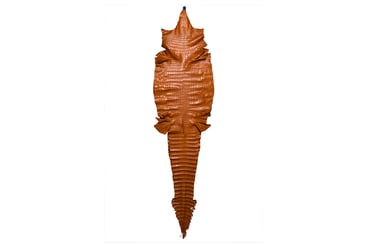 To achieve the high-quality American crocodile skin (also known as acutus crocodile) needed for high-fashion, the skins must go through a process called tanning. Tanning an exotic skin is the crucial process in the transition of raw skin into leather. Without this, the skins are susceptible to bacterial growth and decomposition.
To achieve the high-quality American crocodile skin (also known as acutus crocodile) needed for high-fashion, the skins must go through a process called tanning. Tanning an exotic skin is the crucial process in the transition of raw skin into leather. Without this, the skins are susceptible to bacterial growth and decomposition.
The steps in tanning are extensive, but highly necessary. The process in our Bogota tannery involves:
- Dry salting the hide as a preservative measure
- Beam-house operations
- Soaking skin (to clean)
- Liming for descaling
- De-liming to raise acidity
- Pickling (to soften)
- Chrome tanning to convert organic material into inorganic material
- Shaving to thin and de-grease leather
- Bleaching to remove the natural markings and achieve one uniform color throughout the crocodile skin
- Re-tanning to re-soften the leather for manufacturing of finished products
- Drying (hang-dry or toggle dry)
- Dry cleaning to further de-grease
- Coloring
- Shaving to prepare the leather for the product (garments require thinner skins that handbags or footwear)
- Finishing to seal and apply final look and feel
Beginning Steps
The crocodile skin is delivered from the suppliers having been already salted to remove the moisture and preserve the skin until we start our process. At this time, the hides are highly susceptible to the elements. The first step in the tanning process is soaking, which is where we rinse the salt and dirt off the skins, so they go into the drums nice and clean.
The Tanning Process
Once rinsed, we use a liming process to remove the scales, nails, mucins and natural greases/fats found on the skin. This process also helps to split the fibers to make the collagen in the skin workable. We then de-lime the hide to raise the acidity that is lowered from the liming step.
The exotic hide is then "pickled" in an acidic bath to break down any bone and calcium in the skin to allow the material to be more pliable. Since the acutus has no bone, pickling is a very short process to soften the skin. After this is a chrome bath that makes the hide durable and no longer susceptible to the elements.
At this point, we shave the skins down so that the chrome seeps in deeply and evenly, plus it removes the weight from the skin so the subsequent processes consume less chemicals. The crocodile skins are then bleached to remove the natural markings, so they are all one uniform base color prior to dyeing.
Now, the skins can be stored on the shelf until we receive orders for specific colors.
Final Touches
Once we receive orders, the acutus crocodile skin is re-tanned with vegetable-based products so that the toughened skin from the initial tanning process is made supple again. Skins being used for garments needs to be re-tanned and shaved softer and thinner than skins that are used for other products. The crocodile skin is then either hang-dried or toggled by a special oven that evaporates the remaining water and removes moisture.
The leather is then dyed, shaved to the specific thickness needed for the application, and finished off with protective coatings to have the leather look (glazed, matte, suede, metallic, etc.) and feel (oily, silky, waxy, sturdy) a certain way, and be further protected from the elements. Once these steps are completed, the crocodile skins are ready to be manufactured into finished products, like handbags, garments, shoes, etc.
The tanning process is the place where the magic happens to provide you with the crocodile skin needed for all your leather projects. For more questions on the tanning of other exotic hides such as alligator skin, contact us or download one of our guides!



